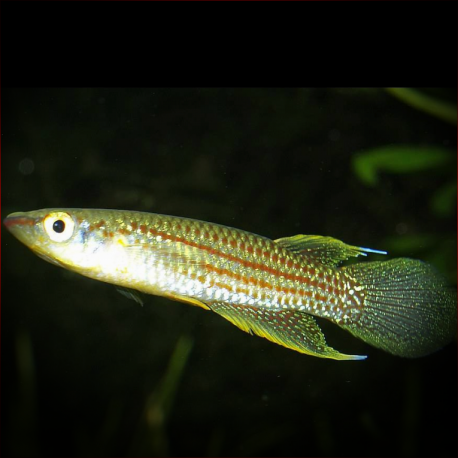More info
Datasheet
| Minimum Tank Size | 40 litres / 10.57 US gallons |
| Maximum Size | 4.0cm / 1.57inches |
| Temperature | 20°C / 68.00°F - 28°C / 82.40°F |
| Hardness | 2.02dgH / 36ppm - 20.00dgH / 357ppm |
| pH | 6.0-8.5 |
General Description
The Dwarf Panchax (Aplocheilus Parvus) is a small fish species belonging to the Aplocheiloid-toothcarps family (Aplocheilidae) within the Cyprinodontiformes order. With an average size reaching up to 4.0 cm, it has an euryhaline nature and is predominantly found in lowland habitats, especially in coastal regions with brackish or freshwater bodies of still or slow-moving water.
Aquarium Setup
For keeping Dwarf Panchax in captivity, a minimum tank size of 40 litres is recommended, with water conditions falling within a pH range of 6.0-8.5, hardness between 36-357ppm, and a temperature range of 20-28°C. They are surface-dwelling predators and are best fed a diet consisting of small live or frozen foods like Artemia, Daphnia, and chironomid larvae (bloodworm), in addition to dried foods.
Behaviour
In their natural habitat, Dwarf Panchax exhibit a preference for areas with surface vegetation or overhanging cover. They are commonly found in environments like mangrove swamps and rice paddies. In an aquarium setting, they can be active swimmers and may display territorial behavior, especially during breeding times.
Feeding and Diet
Aplocheilus Parvus are surface-dwelling predators that primarily prey on both aquatic and terrestrial invertebrates. While they can adapt to accepting dried foods in captivity, it is essential to supplement their diet with regular servings of small live or frozen fare to ensure their optimal health and nutritional requirements are met.
Reproduction & Dimorphism
The breeding behavior of Dwarf Panchax is relatively straightforward. They deposit their eggs in various substrates such as woollen mops, fine-leaved plants, or filamentous algae. The incubation period typically lasts between 10-15 days, with the fry requiring infusoria-grade food initially before transitioning to larger foods like Artemia nauplii and microworms.
Habitat and Distribution
Native to Sri Lanka and Tamil Nadu state in southeastern India, Dwarf Panchax has a distribution that extends to modern-day Chennai, India. Their natural habitats comprise diverse lowland areas, often near the coast, that contain still or slow-moving freshwater or brackish water bodies, where they can find suitable cover and vegetation to thrive.

